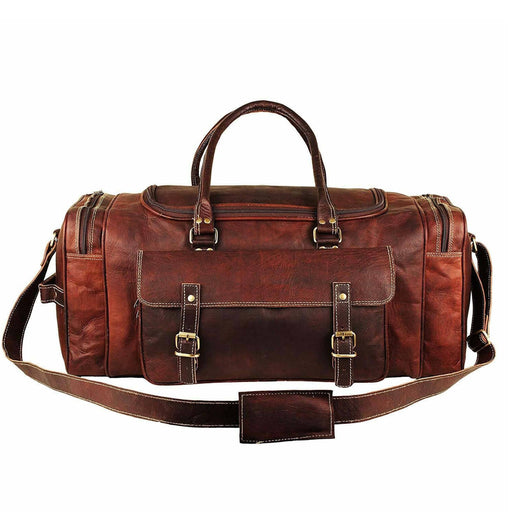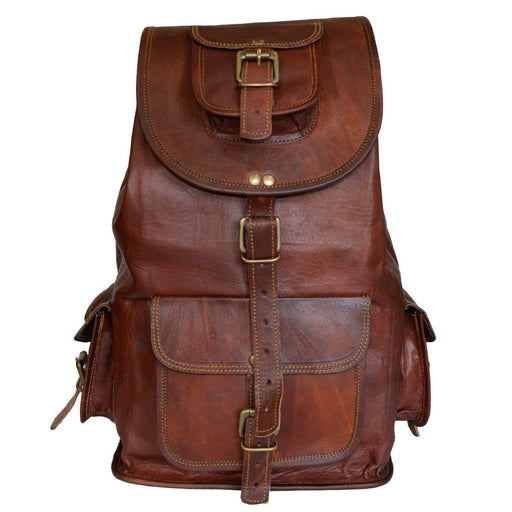
What is Full Grain V/s Genuine Leather V/s Top Grain Leather
Leather products have been around for a long time now; this material was invented in 1200 B.C. and has now been used in several industries as they have proven handy and exceedingly reliable. However, there has always been an ambiguity revolving around in consumers' minds about the quality of the leather, and people also have a hard time identifying the best variant. We’re often handed out low-grade leather articles in the name of top-quality variants; one must know how to differentiate between various types of leather.
Deciphering all the concepts about leather, jotted below are comprehensive facts you must know before buying any leather product from the market.
How do I identify full-grain leather?

Full-grain leather is considered to be the finest form of leather, but customers are quite often tricked into buying a diverse, low-grade article under the name of full-grain leather.
The full-grain leather goes through minimum processing, which means that the animal skin is not sanded down; this is the unaltered version of leather. As the density of fibres is high, one can see the animal skin marks on this kind of leather when observed closely.
To lower your stress level while choosing the top-notch quality of leather, here are some ways for you to identify whether an object is made out of full-grain leather or not:
- As the full-grain leather is made from animal skin and is not tanned, you can easily check out the skin formations, stretch marks, scars, skin moles, and animal hair if you look closely. These are the purest forms of leather; therefore, you can perceive the skin elements of the animal from which they have been carved. If you're not able to find any skin elements, you can also flip the leather over and check on the rear side. If the leather looks extremely plain without any scars or marks, then you can presume that it has been processed or sanded down, losing its fibre and durability.
- These are highly durable, which means that you can identify the pre-owned leather articles of yours by determining whether they lost their shine or tore apart after some time. The full-grain leather does not lose its shine; it looks exclusive all the time, which concludes "forever.
You can take pictures of the leather when you first buy it and then after a few weeks to confirm your scrutiny.
- Smoothness is the prime trait of a full-grain leather object; these are not sanded or corrected, which gives them the silky effect. Gently rub your palm against the leather material; the full-grain will be markedly smoother than other types of leather, and you can to some extent feel the sleek skin of the animal from which the leather has been extracted.
Types of Leather Grades
5 types of leather grades are mentioned below, listed from highest to lowest grade order.
- Full Grain Leather: The most elite form of leather is also considered to be the most durable. These consist of complete grains; therefore, there are no chances of them being torn over uncountable years. This is the purest form of leather, and the fibre density is high as it does not go through lengthy handling.
- Top Grain Leather: These are highly processed from both sides, which makes the natural skin elements wash off of them. It is highly water-resistant; however, products made from it are not quite durable, and with time, you can watch their lustre wear off. Several people get confused between full-grain leather and top-grain leather; one has to inspect thoroughly to differentiate both of them. As these go through several handling processes, they won't bear the skin traces of the animals they have been carved from, and they also won't be as smooth as the full-grain leather on skin.
- Split Grain Leather: In this type of leather, the animal’s skin surface is split into several layers, and then the products are carved out of these separated layers. Mostly the animal skin contains several layers and is thick. In split-grain leather, the skin layers are separated into thin layers, which are then processed and converted into the leather, which is renowned as split-grain leather. This type of leather is considered to be rough on both sides, which makes this a crucial identification factor for choosing leather products in the market.
- Genuine Leather: Contradictory to its name, the genuine leather is not quite genuine. It is a term used by shopkeepers to describe low-quality leather. It is made from the bottom cut, which leaves it with no grains, and these are stiffly processed. In this, many low-quality pieces of leather are coupled together with glue or other holding elements to give it the impression of full-grain real leather. If you do not know about differentiating the types of leather, then you might get duped by their appearance. Remember to look closely and follow the steps stated before to identify high-quality leather.
- Bonded Leather: The lowest grade of leather, made out of scraps or left-overs that are combined with other components like plastic, glue, vinyl, etc. There is not much difference between genuine leather and bonded leather, as both of these are considered to be the lowest grade of leather. This is often created out of paper backer, pulp, or polyurethane and later sculpted like real leather by embossing animal skin imitation. These are no better than faux leather; they are not at all durable and can be easily differentiated from top-quality full-grain leather.
Is full-grain leather real leather?
There's no doubt in the fact that full-grain leather is real leather; in fact, as stated before, it belongs to the top-quality grade of leather and the best one, which is highly durable and doesn't tear off.
These do not undergo vigorous processing, which makes them the purest form of leather one can wish to possess. The thick animal skin is kept intact, and it does not go through any machines or hand processes that help in maintaining the fibre and grain density of the products carved from it.
Leather bags made out of full-grain leather have always been in fashion and in demand; they tend to be the most reliable bags as they do not tear off easily and also do not lose their shine over time.
Now that you’re well versed in the quality variants of leather, you can go shop and identify the best form of leather all by yourself, and you do not need to worry about getting fooled into buying low-grade leather in the name of genuine leather.
Leather Bags for Men
Walker Leather Office Travel Bag
The super-stylish Walker leather unisex duffle bag is undoubtedly a trendsetter all year. This opulent, oblong weekender bag is made...
View full detailsTraveler Weekender Duffle Bag
This is the perfect solution for all your needs. This leather duffle bag has four big pockets on the exterior with two buckles. This...
View full detailsSpencer Hiking Backpack
The Spencer Leather Backpack is the perfect bag for all your adventures because it is designed to hold everything you need for a trip. Wit...
View full detailsWindsor Crossbody Bag
This unique brown leather crossbody bag for men and women will make every outfit of yours stand out effortlessly. This sling bag is handcrafted by ...
View full detailsCambridge Leather Satchel Bag
This handcrafted Cambridge Leather Satchel Bag is an exclusive product of MaheTri's Satchels collection for men and women. At MaheTri's leather ...
View full details




